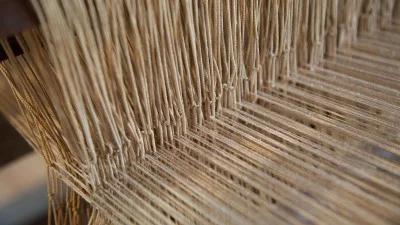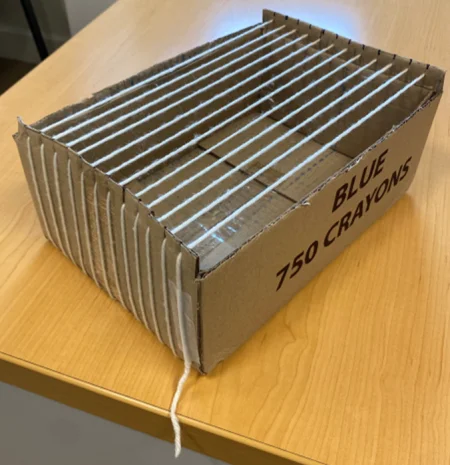Follow these step-by-step instructions to make your own loom.
Supplies Needed
- Sturdy cardboard box with flaps,
rectangular is recommended - Scissors
- Ruler
- Pencil
- String or yarn
- Tape
- Fork
Definitions
Loom: machine used to create fabric
Warp threads: thread that is strung over the loom from front to back
Weft threads: thread that is woven over and under the warp threads
Shuttle: tool used to weave weft threads through the warp thread
Beater: tool that pushes the weft threads tightly together
Step 3
Starting at the left side of the box, push the warp thread into the left-hand slit nearest to you, leaving a 6-inch tail. Tape the tail securely to the box.
Step 4
Wrap the string across the box to the right and push it into the right-hand slit nearest to you. Then, wrap the roll of string under the box and through the next left-hand slit. Make sure you keep the string tight—but not too tight—as you wrap the box.
Step 5
When you reach the last slit, cut the string and tape
the tail to the box.
Step 6
Take one of the leftover box flaps and cut it into a rectangle about 2 inches wide and 6 inches long. Cut a V-shape into both ends of the rectangle. This will be the shuttle, which will be used to weave your weft threads around your warp threads.
Step 7
Cut a long piece of thread to serve as the weft thread. This string will be woven through the warp strings. To avoid getting tangled, don’t make it longer than 10 feet.
Step 8
Wind your weft thread around the center of your cardboard shuttle, keeping the string inside the V-shaped cuts.
Step 9
Starting from the right side of the loom, weave the shuttle through the warp strings, over and under, until you reach the left side. Leave a 6-inch tail at the right.
Step 10
Start weaving the next row on the left side. Each row will be woven opposite the weave of the previous row. For example, if you finished the first row under the warp thread, start the second row over the warp thread.
Step 11
After you finish three or four rows, the weft threads may be a little loose. Use a fork or your fingers as a beater to gently press the weft threads together evenly across the row.
Step 12
When you get to the end of your weft string, cut another 10-foot length of string and wrap it around the shuttle as you did at the beginning. Start weaving a new row, weaving opposite of the last row, and leave a 6-inch tail at the start of the row. Tuck the tails into your weaving so it doesn’t unravel.
Helpful Tips
- Don’t pull too tightly on your weft threads — your weaving will end up crooked!
- If you have trouble tucking your extra weft threads into your weaving, then tie the tails from where one row ended and the next began together.
A Spinning House Demonstration
Historic trades interpreter Margaret Lineberger explains 18th-century weaving.

Clothing of the Enslaved
Mount Vernon’s enslaved people usually had no choice but to wear clothing identifying them as enslaved. Enslaved house servants were provided more and better-quality clothing than field workers.
Sheep at Mount Vernon
Learn about George Washington's sheep population and their role at Mount Vernon.







